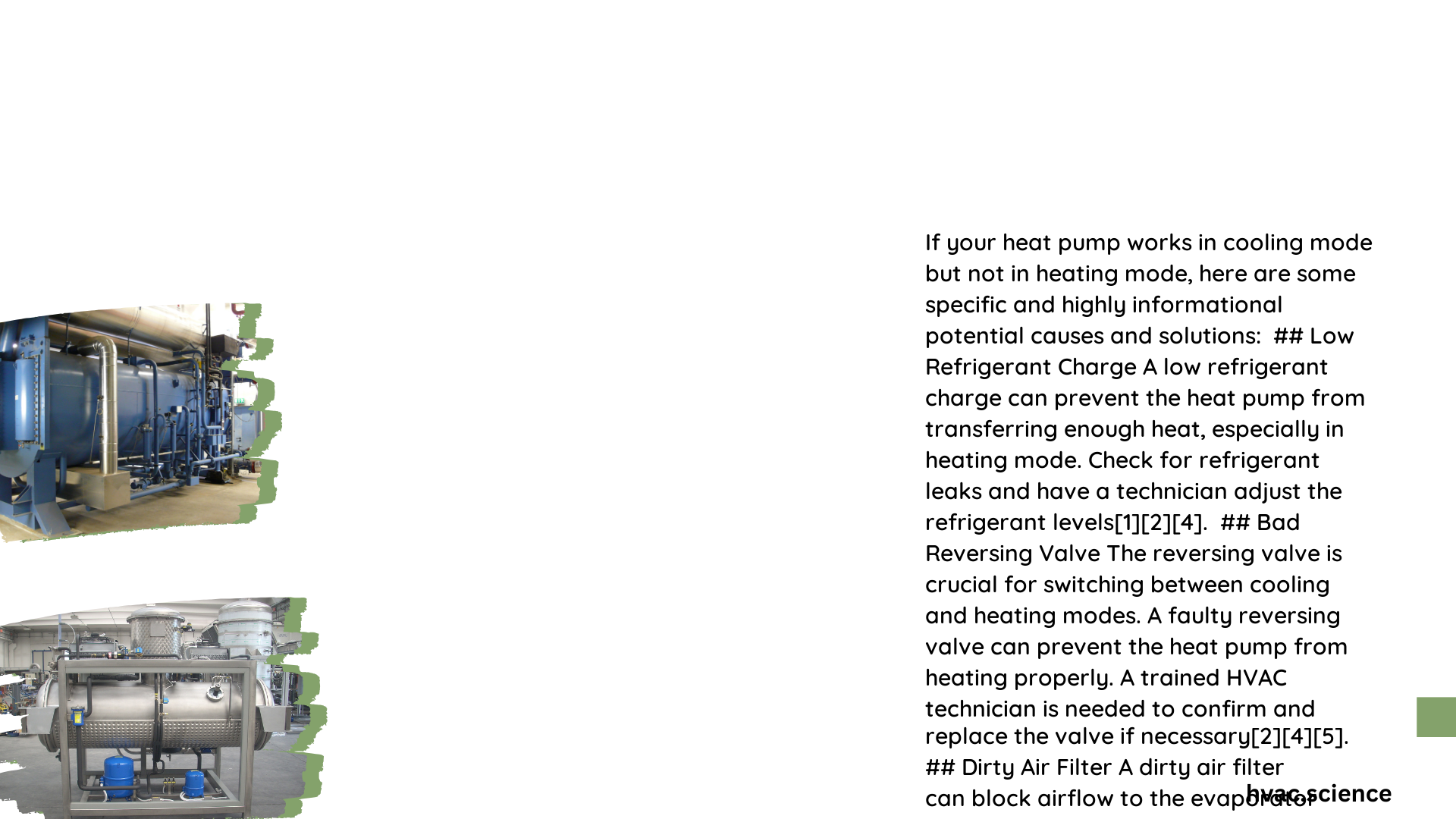A heat pump that works in cooling mode but fails to provide heat is a common issue faced by homeowners. This problem can stem from various factors, including faulty components, refrigerant issues, or thermostat malfunctions. Understanding the root causes and potential solutions can help you troubleshoot the problem effectively and restore your heat pump’s heating functionality.
Why Does My Heat Pump Cool But Not Heat?
The most common reasons for a heat pump to work in cooling mode but not in heating mode include:
- Faulty reversing valve
- Low refrigerant charge
- Thermostat issues
- Dirty or clogged air filter
- Frozen outdoor unit
Let’s explore each of these issues in detail and discuss potential solutions.
What Is a Reversing Valve and How Does It Affect Heating?
The reversing valve is a crucial component in a heat pump system. It’s responsible for switching the flow of refrigerant between heating and cooling modes. When this valve malfunctions, it can cause the heat pump to stay stuck in cooling mode.
Symptoms of a faulty reversing valve:
– Heat pump blows cold air when set to heat
– System works fine in cooling mode but not in heating mode
Solution: A faulty reversing valve typically requires professional replacement. An HVAC technician can diagnose and replace the valve if necessary.
How Does Low Refrigerant Affect Heat Pump Performance?
Refrigerant is the lifeblood of your heat pump system. It’s responsible for transferring heat from one place to another. When refrigerant levels are low, usually due to a leak, the heat pump may struggle to provide adequate heating.
Signs of low refrigerant:
– Insufficient heating
– Ice buildup on the outdoor unit
– Hissing sounds from the unit
Solution:
1. Locate and repair any refrigerant leaks
2. Recharge the system with the correct amount of refrigerant
This task should be performed by a certified HVAC professional due to the complexity and potential environmental hazards.
Can Thermostat Issues Cause Heating Problems?
Yes, thermostat problems can indeed cause your heat pump to work on cool but not heat. Issues can range from incorrect settings to faulty wiring or a malfunctioning thermostat unit.
Common thermostat-related issues:
– Incorrect mode selection (set to ‘Cool’ instead of ‘Heat’)
– Faulty wiring
– Dead batteries (for battery-operated thermostats)
– Miscalibration
Solution:
1. Check thermostat settings and ensure it’s set to ‘Heat’ mode
2. Replace batteries if applicable
3. Verify wiring connections
4. Consider recalibrating or replacing the thermostat if issues persist
How Does a Dirty Air Filter Impact Heat Pump Heating?
A dirty or clogged air filter can significantly reduce airflow in your heat pump system. This restriction can lead to inadequate heating and potential system damage if left unaddressed.
Effects of a dirty air filter:
– Reduced airflow
– Decreased heating efficiency
– Potential system overheating
Solution: Replace or clean your air filter regularly. Most manufacturers recommend checking the filter monthly and replacing it every 1-3 months, depending on usage and environmental factors.
What Causes a Frozen Outdoor Unit and How Does It Affect Heating?
In heating mode, it’s normal for some frost to form on the outdoor unit. However, excessive ice buildup can prevent the unit from absorbing heat from the outside air, leading to heating issues.
Causes of a frozen outdoor unit:
– Low refrigerant charge
– Faulty defrost control board
– Blocked airflow around the unit
Solution:
1. Clear any obstructions around the outdoor unit
2. Check and clean the unit’s coils
3. Have a professional check the refrigerant levels and defrost controls
How Can I Troubleshoot My Heat Pump When It’s Not Heating?

Follow these steps to troubleshoot your heat pump when it’s not providing heat:
- Check the thermostat:
- Ensure it’s set to ‘Heat’ mode
-
Verify the temperature setting is above the current room temperature
-
Inspect the air filter:
-
Replace if dirty or clogged
-
Examine the outdoor unit:
- Clear any debris or obstructions
-
Check for excessive ice buildup
-
Verify circuit breakers:
-
Ensure all relevant breakers are in the ‘On’ position
-
Listen for unusual noises:
- Hissing could indicate a refrigerant leak
- Grinding or squealing may suggest mechanical issues
If these steps don’t resolve the issue, it’s time to call a professional HVAC technician for a thorough diagnosis and repair.
When Should I Call a Professional for Heat Pump Repairs?
While some troubleshooting steps can be performed by homeowners, certain issues require professional attention. Call an HVAC technician if:
- You suspect a refrigerant leak
- The reversing valve appears to be faulty
- Electrical components are malfunctioning
- The system is making unusual noises
- You’ve performed basic troubleshooting without success
Remember, attempting complex repairs without proper knowledge and tools can lead to further damage and potentially void your warranty.
Conclusion
A heat pump that works on cool but not heat can be frustrating, especially during colder months. By understanding the potential causes and following the troubleshooting steps outlined in this guide, you can often identify the issue and take appropriate action. Regular maintenance, including filter changes and professional check-ups, can help prevent many of these problems and ensure your heat pump functions efficiently in both cooling and heating modes.
References:
1. Why Is My Heat Pump Not Switching to Cooling Mode?
2. Why Is My Heat Pump Not Blowing Hot Air?
3. Heat Pump Not Cooling? Here’s 6 Reasons Why
4. Troubleshooting Heat Pump Problems
5. Common Heat Pump Problems and Solutions
